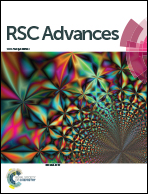Photocatalytic degradation and pathway of oxytetracycline in aqueous solution by Fe2O3–TiO2 nanopowder†
Abstract
The degradation behavior of oxytetracycline (OTC) in aqueous solution using Fe2O3–TiO2 nanopowders (Fe2O3–TiO2 NPs) as photocatalysts under UV/visible light was investigated in this paper. Fe2O3–TiO2 NPs photocatalysts synthesized using co-precipitation were characterized by XRD, TEM, FT-IR and UV-vis DRS. Fe2O3–TiO2 NPs with 45 wt% Fe2O3 exhibited higher photocatalytic activity than others. The photocatalytic degradation of OTC shows a maximum efficiency at pH = 5.5 under both UV/visible light due to the surface adsorption. The intermediate products during the photocatalytic degradation of OTC were detected by LC-MS/TOF. Seven main intermediates were formed, and their evolution was discussed. On the basis of the evidence oxidative intermediate formation and a detailed degradation path way of OTC by 45 Fe2O3–TiO2 NPs are proposed.


 Please wait while we load your content...
Please wait while we load your content...